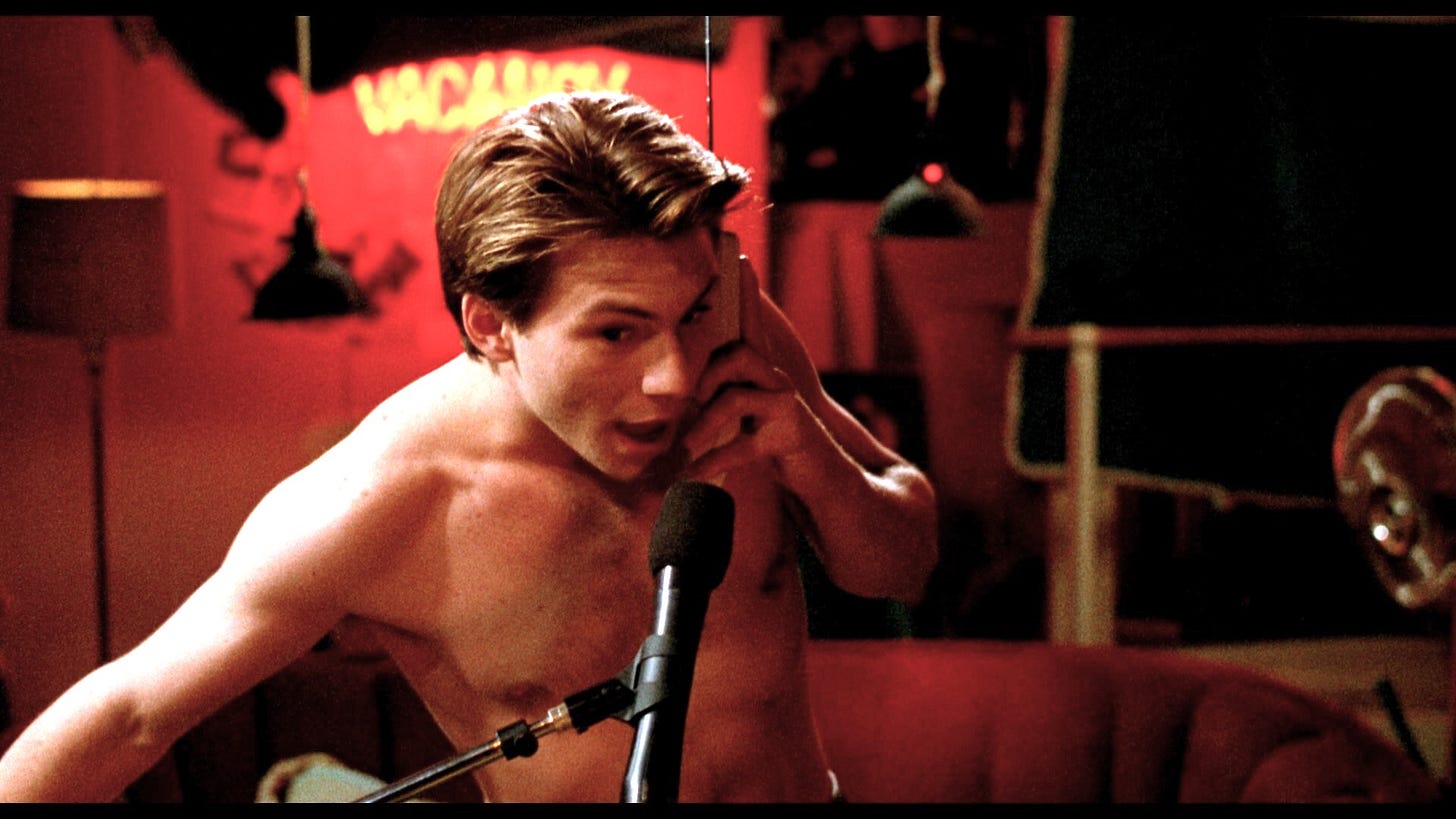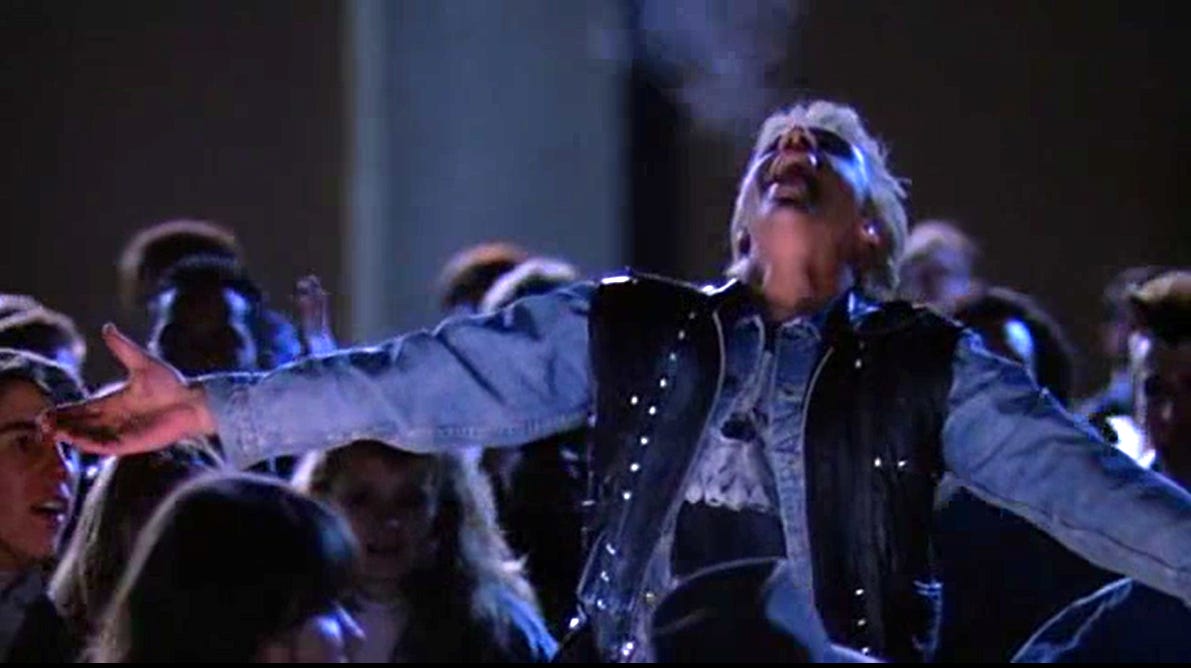Talk Hard?: 'Pump Up the Volume' (1990)
Watching Gen-X cult classic 'Pump Up the Volume' in a post-radio age
SEVERAL NOTES: This essay references suicide and self-harm. And please note that SPOILERS lie ahead. This film is tough to find online, no doubt thanks to the music clearances. I have it on good authority, though, that one can locate Pump Up the Volume on archive.org.
The line that demarcates Generation X from its Millennial successors is, per the Pew Research Center, 1981. Conveniently, this partition can be mapped onto the rapidly shifting technological landscape of the 80s and 90s, where Gen-X is linked with the penetration of personal computing into American homes and Millennials with the widespread adoption of the internet.
Born in January of 1980, I’ve often felt like I occupied a liminal space between the two — either a baby Xer or a geriatric Millennial. The tech gadgets of my youth attest to this line-straddling. I grew up with a PC that ran MS-DOS and 5.25” floppy discs, but in middle school I was an early adopter of both CompuServe and AOL; by the time I was 16, I’d managed to own both an Atari 2600 and a Sony PlayStation; and yet in high school, I still relied on a beeper and pay phones to communicate with friends while on the go, and I didn’t own my first cell phone until I was 23 and out of college.
Despite being situated in this generational juncture, I’ve always identified as Gen-X thanks largely to the pop culture I consumed. My only sibling is 14 years my senior, so some of his tastes trickled down to me. And as a fairly precocious kid, I developed at a young age a voracious appetite for movies and TV, one abetted by my parents’ lax oversight of what I watched. Thus, even in middle school, I felt like, or at least longed to be, one of the aimless twentysomethings I saw in Slacker (1990), Bodies, Rest & Motion (1993), Reality Bites (1994), and Clerks (1994).
This is how I, at age 11, developed a deep affection for Allan Moyle’s Pump Up the Volume (1990), a film that I, until this week, had not seen in close to 30 years. In it, Christian Slater — the very embodiment of early 90s teen disaffection — plays a disaffected teen named Mark who disguises his voice and adopts the non de plume Happy Harry Hard-On to host a pirate radio show out of his parents’ basement. Something of a cross between a countercultural Howard Beale and a foul-mouthed Dear Abby, he rhapsodizes on the crucibles of suburban high school life and offers frank counsel to peers who write in. A rebel without a cause, with a microphone.
At the risk of sounding nostalgic for the past or overly cynical about the present, I fear the likelihood of Pump Up the Volume’s assortment of jocks and poets, fuck-ups and Ivy League-aspirers moving from isolated individuals into a youth coalition, and the means by which they do so, almost unimaginable in the context of today.
On this re-watch, I was surprised at how well the movie’s depiction of teenage isolation has aged, how it still resonates. But at the risk of sounding nostalgic for the past or overly cynical about the present, I fear the likelihood of Pump Up the Volume’s assortment of jocks and poets, fuck-ups and Ivy League-aspirers moving from isolated individuals into a youth coalition, and the means by which they do so, almost unimaginable in the context of today.
Watching Pump Up the Volume from the present vantage, and on my laptop no less, I’m struck by just how quaintly analog the whole thing is: dubbed cassettes are passed on school buses; Mark cues up Leonard Cohen records on his turntable; phone conversations, because of landlines, are anchored to fixed locations; and fan letters travel via snail mail to the hero’s post office box. A teacher even comments on Mark’s sloppy penmanship on a hand-written composition.
Notably, the world of Pump Up the Volume is, at least among the students, largely a television-free world. We see parents tuning in to the news while at the dinner table (partly for expository reasons), but the kids appear immune to the lure of MTV and reruns that are so often cast as enervating in Gen-X artifacts like Beavis & Butthead and Reality Bites. Moyle seems hesitant to lay the blame for adolescent angst on mass media, seeing the root of the problem elsewhere, with parents and teachers and guidance counselors who fail to see or hear the cries of young people.
And then there’s the radio. In the film’s opening seconds, we hear Happy Harry in voiceover as the camera scans, as if surveilling, a suburban Arizona neighborhood at night. It’s fitting that a film about a pirate radio host would come to us viewers as a disembodied voice. After all, it’s part of the appeal of the medium — the seeming intimacy of communication that is nevertheless open to all, but neither speaker nor listener can be certain that anyone else is actually on the other end of the communiqué. Though transmitted broadly, radio can sometimes feel narrow, one-to-one.
Were we to transpose this film into a contemporary context, Mark’s show would almost certainly be a podcast. He’d record the episodes, upload them to a server, and his audience would listen asynchronously and at their convenience. Fans’ chatter about it would most likely happen on message boards or social media platforms.
True to the era, news of the libidinal Happy Harry show travels principally by word of mouth, and Moyle cleverly makes visible the growth of Mark’s audience. Early in the film, we see listeners tuning in alone in their bedrooms or cloistered in cars. But as one character relays to a friend, and to us, the reception is best in the expanse of the high school baseball field. Over time, greater numbers of cars occupied by a widening mélange of cliques congregate there, and when Mark’s monologues reach fever pitch, the field vibrates with cheers, dancing, vandalism, and beer-drinking — a party, in other words.
As word spreads of Happy Harry’s rebellious broadcasts, students blast recordings thereof during lunch, drawing the uninitiated and the converts to huddle around boomboxes — at least until administrators resolve to shut Mark’s agitations down and ban the tapes for being played on school grounds. But even then, across several days, students turn the spot where they listened at school into a protest zone, with geeks and football players, fat kids and burnouts carrying homemade signs adorned with Mark’s catchphrases of “so be it” and “talk hard!”. Ever enterprising, some of the students manage to rig the public address system to pipe in Happy Harry’s rantings campus-wide.
Bodies can be caged or constrained, but voices carry and respect not boundaries.
Media scholar Michele Hilmes argues that radio in the early- to mid-20th century helped stitch together what Benedict Anderson called the “imagined community.” Despite great geographic, racial, ethnic, religious, and socioeconomic diversity among American listeners, the shared experience of tuning in to the same radio program at the same time created something of a unifying social experience for the still nascent nation. Great swaths of people who were unlikely to ever meet or interact felt connected to one another nevertheless.
Of course, the media landscape of today is far more fractured, niche, and dispersed. Outside the Super Bowl, there are few mediated experiences that come close to that sort of ubiquity. Perhaps that’s why seeing Pump Up the Volume 30 years later leaves me so discouraged. In 2024, could a teenager’s cri de coeur ever hope to find a large enough audience to galvanize an entire school?
It is implied that Mark’s impassioned, disillusioned basement dispatches began with him speaking into a microphone to no one. And then one or two people tuned in, likely by accident while spinning the dial, and recognized themselves in his words, then told friends. Before long, all the social strata of the high school coalesce in its playing fields and parking lots for the communal, cathartic experience of realizing that despite their vast differences, they are, in some ways, the same, or suffer under the same conditions.
I’m reminded of iconoclastic philosophers Gilles Deleuze and Félix Guattari and their refrain that “the people are missing.” Surely, individuals go about their day among other people, but they are not bound to one another, do not “belong” to one another. In conventional thinking, those binding ties are ancestral (the homeland, the mother tongue, and patriarchal progenitor), and we find them and refortify them by looking backwards. Deleuze and Guattari counter this with a different conception of the “people,” one that is emergent, called into being, activated — disparate parts formed into a whole, facing forward.
What we see at the end of Pump Up the Volume seems to me to a people of the latter sort, unified by their recognition, via Mark’s broadcasts, that they suffer under the same plight. In the film’s final moments, the assembled mass of teenagers shout words of gratitude and encouragement to Mark, whom they had heretofore only known as Harry, as he is taken into custody by police for FCC violations. As the camera pulls away from the scene via crane, and in a callback to the movie’s opening, we hear a new set of disembodied voices, no fewer than a dozen, all young, signing on to radio shows from Massachusetts to Los Angeles. One is a helpline for runaways, another on gang violence, one simply asks, articulating perhaps the most universal of teen sentiments, “Can anybody hear me out there?”.
Who knows if the activism born out of Mark’s show and his Tom Joad persona will endure or if it will have any impact? Certainly, the troubles the kids in Pump Up the Volume face have not gone away. And then there’s the question of technology. Radio is by no means obsolete but no longer the cultural touchstone it once was. My teenage daughter, for instance, has never willingly listened to a radio broadcast, and never outside the confines of a car with adults in it.
In 2024, the likelihood of a student body listening en masse to a Happy Harry-style podcast or reading the same firebrand Instagram account seems remote, let alone becoming mobilized by them. I don’t mean to suggest that the possibility of political coalition-building and political agency among young are impossible in the digital age; we’ve seen Never Again MSD emerge in the wake of the Parkland, Florida, high school massacre, Greta Thunberg’s far-reaching climate activism, and all manner of youth-driven, grass-roots movements following the deaths of Breonna Taylor and George Floyd by hands of police in 2020. There can be little doubt that much of that organizing happened online amongst far-flung activists.
Ultimately, thought, what most discourages me about the 21st-century prospects of a pseudonymous rabble-rouser generating a coalition on web forums, social media, podcasts, and YouTube channels is that, if effective, it would look less like what we see in Pump Up the Volume, where young people revel in recognizing that they aren’t alone in this world and that by virtue of that fact possess some power to effect change:
And more like this:
Perhaps that’s too cynical, but what else would you expect from an aging baby Xer like me?
If you appreciate the writing here at Material Ghosts, please consider subscribing or sharing it with your networks.







